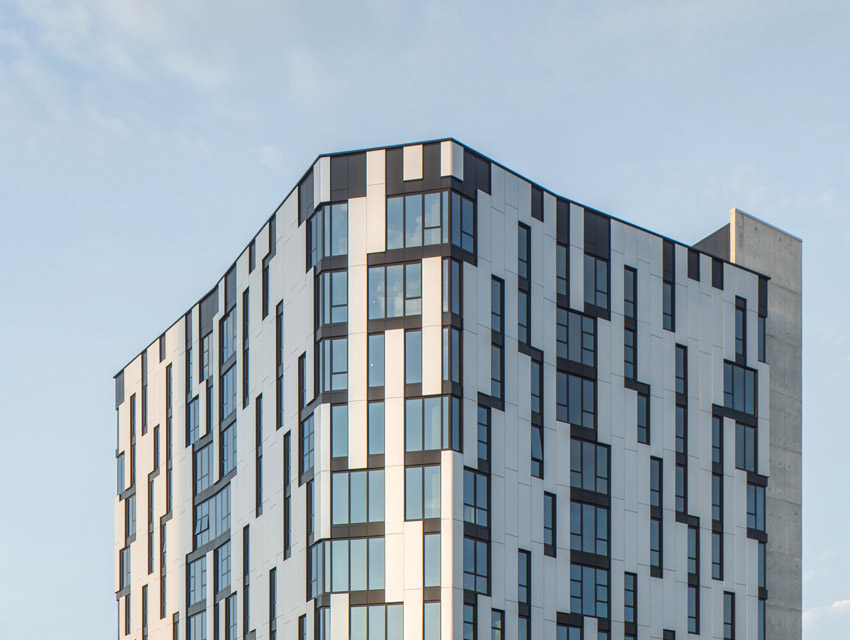Armed with the various design options offered by insulating metal panels, together with some best practices for project coordination and installation, architects will be best equipped to deliver successful IMP wall and roofing projects.
Known for its exceptional aesthetics, envelope performance, spanning abilities, and one-step installation, insulated metal panels (IMPs) are a popular choice for today’s commercial, institutional, and industrial facilities.
Breaking out beyond its traditional cold-storage applications, architects and building owners are taking advantage of IMPs’s growing architectural options, aesthetics, structural integrity, energy efficiency, lightweight, and low maintenance for a wide variety of projects ranging from corporate settings to sports facilities to educational buildings.
“Using IMPs is a frequent practice with many of our projects,” reports Cassie Robertson, preconstruction manager, DPR Construction, Phoenix. “If you have a client that’s looking for a good-looking facade but not wanting to exert the time, money, and effort on a customized project, IMPs are a great solution to get an insulated facade up rather quickly.”
“They are a holistic design solution, which drastically reduces install time in lieu of other materials that require multiple trades and multiple schedules,” adds Bruce Beahm, AIA, principal, Populous, Kansas City, Missouri.
As a turnkey option, delivering a full vapor and water barrier—along with continuous insulation— IMPs are an easy way to meet growing code requirements, which Robertson says is a major selling point amongst end users.
To deliver this high-performance insulation, foam is injected between two metal sheets where it then undergoes a chemical reaction, causing it to rise and bond to the metal skins, thereby filling the interior cavity. The result is a solid monolithic panel that maintains a consistent thermal value and also resists moisture, insect, and rodent infiltration.
As of recently, IMPs are not only considered the primary exterior finish but are also now being designed in as the primary building envelope that can be clad with various secondary rainscreen materials, relates Dan Hooper, president, Universal Wall Systems, Grand Rapids, Michigan.
“This barrier wall provides a quick building enclosure over a simple framing system that can facilitate the schedule of the interior buildout, and ultimately reduce the overall project schedule and cost of the project general conditions,” he says.
Array of Design Options
Coming a long way from the uniform, boxed designs of the 1960s, today’s IMP manufacturers offer a growing palette of design options, including a wide range of flat and profile panels, color, texture, panel width, joint size options, and joint orientations. IMPs can also be curved and formed, and come in a variety of high-performance coatings.
“IMPs have developed from the early ribbed metal-faced panels to now include a variety of smooth and textured metal modular wall panels integrated with reveals, trim, windows, and louvers,” reports Phil Kazba, FCSI, CCS, AIA, SpecGuy Specifications Consultants, Mount Dora, Florida.
Expanding upon the various profiled options, designers can choose walls that are ribbed, fluted, or planked. For flat walls, they can be flat, textured, or striated.
Additional design features include joint reveal widths, formed corner panels, end folds and treatments, heavier gauge flat facings, and high-performance coatings. Performance wise, architects can specify various panel insulation values, span lengths, and load/span capabilities.
“From an architectural perspective, the panel sizes, orientation jointing, exposure, cuts, texture, etc. are all commonplace items to consider with metal panel fabrication,” explains Robertson.
For IMP roof systems, the latest products come in a nice array of colors, textures, finishes, and sizes. Typical modules are sized at 24 inches, 30 inches, 36 inches, and 42 inches, with thicknesses ranging from 2 inches to 6 inches, and lengths from 8 feet up to 52 feet.
For improved appearance with economy, architects can specify multiple profiles to the metal facing, such as light striations, planking, deep ribbing, or stiffening beads.
Another feature is embossing, which creates surface texture on metal coils. This process flattens wavy coils and eliminates the “mirror” effect of smooth finishes. It is also a useful way to mask minor blemishes such as paint scratches and surface variations. Nondirectional embossing can be applied to create a uniform pattern, whereas directional embossing produces linear lines along the length of the coil.
The most commonly used metal substrate for IMP faces are G90 galvanized steel or aluminum-zinc coated steel, while some custom panels are made from stainless steel or aluminum.
A typical interior finish is a standard polyester 0.8 millimeter—including the primer—in a light-reflective and easy-to-maintain color. United States Department of Agriculture (USDA)-compliant finishes and stainless steel are also available for required applications, such as food processing and storage.
To help architects navigate through the various options, Kevin Haugh, AIA, architect, associate, CRB, Broomfield, Colorado, recommends working with product reps to gain exposure and gather input on the different uses and types of panels offered. “Manufacturers have the experience and product knowledge to steer architects to the right product for the application,” he says. “Usually the architectural conceptual design will drive the panel profile. Then, using vendor information, we find a panel that meets the design intent.”
“Invite these manufacturers to your office for a discussion around current projects these solutions could apply to and allow them to demonstrate their product lines and show photos of built projects,” agrees Beahm. “They can be a valuable guide when selecting the right IMP system for specific projects to ensure the product meets the design intent and is detailed to include proper fit and finish.”
Incidentally, Beahm also recommends visiting built projects to see the products installed first hand. This includes speaking with venue owners who utilize IMPs and asking them about their satisfaction levels.

